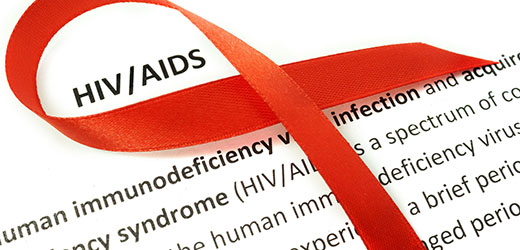

Clinical spectrum
HIV infection can generally be broken down into distinct stages:
| Entry of HIV into the human body | 2-3 weeks |
| Acute retroviral syndrome | 2-3 weeks |
| Clinical improvement and seroconversion | 2-4 weeks |
| Asymptomatic chronic HIV infection | 8 years |
| Symptomatic HIV infection | 1,3 year |
| Death |
Acute retroviral syndrome is the first stage of HIV infection, which is related with decrease of CD4+ count. There is a high viral load in the blood.
The clinical manifestation of the syndrome is wide. The most frequent clinical picture is an influenza-like illness.
The signs and reported symptoms are fever, lymphadenopathy, faringytis, rash, myalgias and arthralgias. Also, oral candidiasis, mucocutaneous ulcerations and loss of weight can occur.
The RNA concentration of HIV is increases during the acute infection and than it decreases which is related to the immune response and seroconversion.
Symptomatic HIV infection is mainly caused by the emergence of opportunistic infections and cancers that the immune system would normally prevent.
Symptomatic HIV infection is often characterised by multi-system disease. Treatment for the specific infection or cancer is often carried out, but the underlying cause is the action of HIV as it erodes the immune system. Unless HIV itself can be slowed down the symptoms of immune suppression will continue to worsen.
As the immune system becomes more and more damaged the illnesses that present become more and more severe leading eventually to an AIDS diagnosis.
This stage of infection lasts for a few weeks and is often accompanied by a short flu-like illness. In up to about 20% of people the symptoms are serious enough to consult a doctor, but the diagnosis of HIV infection is frequently missed.
During this stage there is a large amount of HIV in the peripheral blood and the immune system begins to respond to the virus by producing HIV antibodies and cytotoxic lymphocytes. This process is known as seroconversion. If an HIV antibody test is done before seroconversion is complete then it may not be positive.
This stage lasts for an average of ten years and, as its name suggests, is free from major symptoms, although there may be swollen glands. The level of HIV in the peripheral blood drops to very low levels but people remain infectious and HIV antibodies are detectable in the blood, so antibody tests will show a positive result.
Research has shown that HIV is not dormant during this stage, but is very active in the lymph nodes. Large amounts of T helper cells are infected and die and a large amount of virus is produced.
A test is available to measure the small amount of HIV that escapes the lymph nodes. This test which measures HIV RNA (HIV genetic material) is referred to as the viral load test, and it has an important role in the treatment of HIV infection.
Over time the immune system loses the struggle to contain HIV. This is for three main reasons:
The lymph nodes and tissues become damaged or 'burnt out' because of the years of activity;
HIV mutates and becomes more pathogenic, in other words stronger and more varied, leading to more T helper cell destruction;
The body fails to keep up with replacing the T helper cells that are lost.
As the immune system fails, so symptoms develop. Initially many of the symptoms are mild, but as the immune system deteriorates the symptoms worsen.
As the immune system becomes more and more damaged the illnesses that present become more and more severe leading eventually to an AIDS diagnosis.
At present in the an AIDS diagnosis is confirmed if a person with HIV develops one or more of a specific number of severe opportunistic infections or cancers.
Opportunistic infections are infections caused by organisms and usually do not cause disease in a person with a healthy immune system, but can affect people with a poorly functioning or suppressed immune system.
Asymptomatic
Generalized lymphadenopathy
Performance scale 1: asymptomatic, normal activity
Weight loss <10% of body weight
Minor mucocutaneous manifestations (seborrheic dermatitis, prurigo, fungal nail infections, recurrent oral ulcerations, angular cheilitis)
Herpes zoster within the last five years
Recurrent upper respiratory tract infections (i.e. bacterial sinusitis)
And/or performance scale 2: symptomatic, normal activity
Weight loss > 10% of body weight
Unexplained chronic diarrhoea, > 1 month
Unexplained prolonged fever (intermittent or constant), >1 month
Oral candidiasis (thrush)
Oral hairy leucoplakia
Pulmonary tuberculosis
Severe bacterial infections (i.e. pneumonia, pyomyositis)
And/or performance scale 3: bedridden <50% of the day during last month.
HIV wasting syndrome (i)
Pneumocystic carinii pneumonia
Toxoplasmosis of the brain
Cryptosporidiosis with diarrhoea >1 month
Cryptococcosis, extrapulmonary
Cytomegalovirus disease of an organ other than liver, spleen or lymph node (e.g. retinitis)
Herpes simplex virus infection, mucocutaneous (>1 month) or visceral
Progressive multifocal leucoencephalopathy
Any disseminated endemic mycosis
Candidiasis of esophagus, trachea, bronchi
Atypical mycobacteriosis, disseminated or pulmonory
Non-typhoid Salmonella septicemia
Extrapulmonary tuberculosis
Lymphoma
Kaposi's sarcoma
HIV encephalopathy (ii)
And/or performance scale 4: bedridden >50% of the day during last month.
HIV wasting syndrome: weight loss of >10% of body weight, plus either unexplained chronic diarrohea (>1 month) or chronic weakness and unexplained prolonged fever (>1 month).
HIV encephalopathy: clinical findings of disabling cognitive and/or motor dysfunction interfering with activities of daily living, progressing over weeks to months, in the absence of a concurrent illness or condition, other than HIV infection, which could explain the findings.
Features
High-level professional and experienced physicians work in our center
Experience
Quality
Positive
24 Hours
